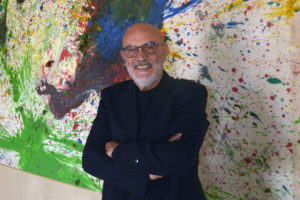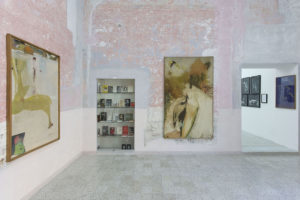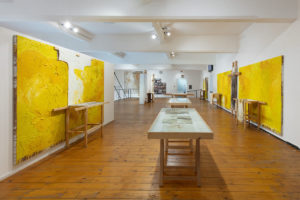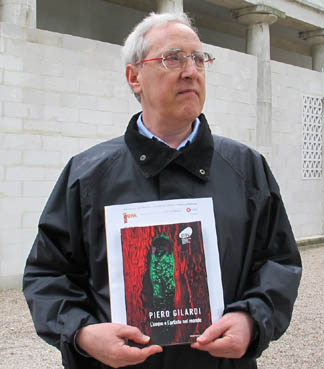Dear Peppe, you are really a crucial point in contemporary culture: first with the Studio Morra settled in via Calabritto, then with the foundation of the Museo Nitsch, now with the Casa Morra, which obviously is not just a house, but an entire building dedicated to cultural activities and archive. Let’s start from this last adventure: how and why Casa Morra was born?
The main target of the Morra Foundation’s activity is art as a love of research and knowledge. A premise that strongly recalls social, ethical and aesthetic goals as a horizon of meaning to follow. In this wake and to expand the area of promotion and cultural education, Casa Morra – Archive of contemporary art was born. Reading and disseminating the complex dynamics that occur in the micro and macro-social systems of communicative culture economies, it is an industrious place that makes the idea of space open to the community, research and experimentation tangible. The planning of the activities – exhibitions, workshops, conferences, workshops, shows, screenings, training projects – reflects his vocation to be not only a place of conservation and exhibition of the heritage but also, and above all, a laboratory of cultural experimentation and innovation, of study, research and production of aesthetic contents of our time. A House where the encounter with art can become a multidisciplinary experience, where to study contemporary society through materials and archives aimed at everyone, focused on the relationship between the person and art, in a perspective of continuous research and learning. A commitment that is expressed through specific training methods such as peer education paths for schools, for groups and associations; such as combinatorial creativity lessons and workshops for university students and Academies or other institutions, and workshops with teachers, scholars and artists. In fact, we count a lot on the younger visitors, on their ability to know how to deepen the knowledge of the “wonderful contemporary”. Casa Morra, as well as being the exhibition site of the collection that I propose annually through an ideal project up to 2116, has an important nucleus of archives of global importance. For example the Living Theater archive, with around 100 works, 400 drawings, posters, costumes, sets, photographs, correspondence. Or that of the Gutai group and in particular of Shōzō Shimamoto, a pivotal figure of the movement, one of the most experimental artists of the second post-war period. An interest that I have developed since 1986 with a series of works from Turin (from an exhibition by Luciano Pistoi) gradually implemented through the establishment of the Shōzō Shimamoto Association, together with Rosanna Chiessi, born to promote and support the master’s research, not only through the publication of catalogs, videos and documentaries, but also by producing some of the performances that made him famous throughout the world. Today the Morra Foundation holds among the greatest works of the master gutai that together with the collection of the Living Theater and that of Hermann Nitsch, constitutes our most important patrimony. Our cataloging work also takes care of the archives of Luca Maria Patella, Vettor Pisani, Arrigo Lora Totino, Jackson Mac Law, and much more of visual, concrete poetry, the subject of continuous study and exchange of materials: with the Getty Center of Los Angeles, for example, or with the University of Victoria, Vancouver, with Yale University, with the Beineck Library. Thanks to the synergies that we establish with institutions and cultural institutions in an interdisciplinary sense, Casa Morra is a mechanism that opens up and connects to the outside world, acting as an observation point for great artistic experiences, an incubator for projects that also involve the local artisan community of mediation with national and international quality organizations. The program guidelines followed so far have led to successful examples. On these path we intend to continue to deepen them further.
Then, going backwards, we arrive at the Museo Nitsch. With Nitsch for you it was love at first sight, a kind of partnership that has lasted since the Seventies…
Always impatient with all forms of “non-change”, I prefer the relays of knowledge between distant universes, and connect them. Taking an interest in a certain thing often leads me to cultivate another. In fact, through Günter Brus, I started attending Hermann Nitsch. Being his friend, Brus introduced him to me and after a few weeks he and Beate were in Naples. We spent a few nights together. Nitsch talked to me about philosophy and cosmology and I – fed by the readings of Stirner, Nietzsche, Hölderlin – was very attracted to those theories. I was seduced by the concept of a total work of art, influenced not only by the five senses, but also by music, poetry, literature, Greco-Roman philosophy and all ancient theater. Therefore, in the ‘74 Hermann Nitsch realized, in the space of via Calabritto, in Naples, an unforgettable action. I immediately understood the difference and the sacralization, which fused pictorial tradition and dramaturgy translated into joy of living. More than a traveling companion, for me Nitsch is a great master. The Museum dedicated to him is like a pulsating center for communicating and acting; where, following a project line, art is not guarded but rather lived. The theatrical device of his works and the show they generate lead to reflections, deepening, aesthetic catharsis, joy of existing. The Museum in fact transforms itself, periodically, with events dedicated to the Viennese master linked by the red thread of a logical and emotional recomposition. The alternation and presentation of the works carried out over time by Nitsch support high-impact re-compositions, which make the space a place in the making, where experimentation and learning processes can be determined.
After so many years what do you see radically changed in contemporary culture compared to the experimentations of the Seventies?
The generational choice that manifested itself at the beginning of the Seventies had made art complete a turn. Today I notice a dialectical relationship between opposing positions. The search for a neo-humanism, together with the value of the local genius; the International Style, as opposed to its drift, the Globalism. But history never repeats itself in the same way, and the result will never depend on the mathematical sum of trends. Rationality is not enough to determine the story, just as dialectical opposition is not enough to account for the complexity of reality, not even the artistic one. In this age of acute crisis, of crisis in the crisis, the backtothefuture, for example, is seen as the return to a near past with the underlying intention to correct the errors of the news, in its concomitance with market interests; it is a viaticum, an escape from the impasse caused by creative fatigue. As for my work, since the 70s the same inner drives support me, and the same intention to work with those artists who over the years have not changed their vitality of continuous experimentation. All the artists of those years are constantly re-proposed. I speak for example of Luca Maria Patella, whose concept is a combination of heuristics and hermeneutics, with continuous variations and technical-medial transmigrations. Slips that generate, from time to time, new awakenings related to poetic-scientific visions. Or I think of Vettor Pisani, expression of a poetic quality and artistic sensibility among the most seductive of the contemporary art world: two artists whose works find space in Casa Morra including their archives, as I have already said, rich in reference materials for students, scholars and teachers. Although the protagonists of the Seventies are now over seventy years old, their work still appears far ahead and of inspiration for the last generations. The aesthetic tensions of our time are, in fact, the extension of the artistic expressions of past eras, even if with radically different expressive forms. There is an urgent need to restore meaning to the work, to restore centrality to the idea, meeting new technologies and new languages projected into the future and into other worlds.
Info:
 Giuseppe Morra davanti a un’opera di Shimamoto, ph. Fabio Donato © Fondazione Morra
Giuseppe Morra davanti a un’opera di Shimamoto, ph. Fabio Donato © Fondazione Morra
 Associazione Shōzō Shimamoto, Palazzo Spinelli di Tarsia, Napoli. Ph. Fabio Donato © Associazione Shozo Shimamoto
Associazione Shōzō Shimamoto, Palazzo Spinelli di Tarsia, Napoli. Ph. Fabio Donato © Associazione Shozo Shimamoto
 Luca Maria Patella, Patella ressemble a Patella L’opera 1964-2007, Castel Sant’Elmo, Napoli, 2007. Ph. Fabio Donato © Fondazione Morra
Luca Maria Patella, Patella ressemble a Patella L’opera 1964-2007, Castel Sant’Elmo, Napoli, 2007. Ph. Fabio Donato © Fondazione Morra
 Vettor Pisani, Il mio cuore è un cupo abisso, Casa Morra Archivio d’Arte Contemporanea, Napoli. Ph. Amedeo Benestante © Fondazione Morra
Vettor Pisani, Il mio cuore è un cupo abisso, Casa Morra Archivio d’Arte Contemporanea, Napoli. Ph. Amedeo Benestante © Fondazione Morra
 Sala Julian Beck, 2° anno di mostre – Casa Morra Archivio d’Arte Contemporanea, Napoli. Ph. Amedeo Benestante © Fondazione Morra
Sala Julian Beck, 2° anno di mostre – Casa Morra Archivio d’Arte Contemporanea, Napoli. Ph. Amedeo Benestante © Fondazione Morra
 First floor, Museo Archivio Laboratorio per le Arti Contemporanee Hermann Nitsch, Napoli. Ph. Amedeo Benestante © Fondazione Morra
First floor, Museo Archivio Laboratorio per le Arti Contemporanee Hermann Nitsch, Napoli. Ph. Amedeo Benestante © Fondazione Morra

He is editorial director of Juliet art magazine.






NO COMMENT